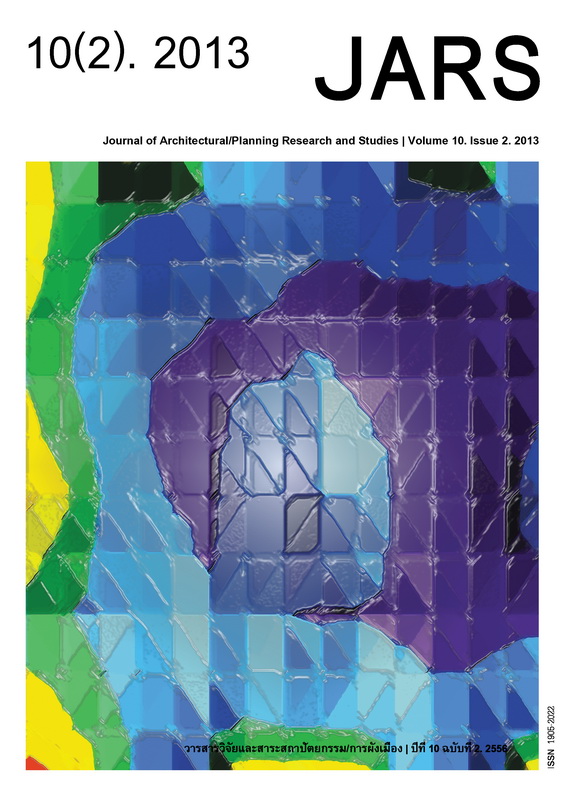Saranrom Garden: From Siamese Royal Garden to Thailand's Public Park
Main Article Content
Abstract
Downloads
Article Details

This work is licensed under a Creative Commons Attribution-NonCommercial-NoDerivatives 4.0 International License.
All material is licensed under the terms of the Creative Commons Attribution 4.0 International (CC-BY-NC-ND 4.0) License, unless otherwise stated. As such, authors are free to share, copy, and redistribute the material in any medium or format. The authors must give appropriate credit, provide a link to the license, and indicate if changes were made. The authors may do so in any reasonable manner, but not in any way that suggests the licensor endorses you or your use. The authors may not use the material for commercial purposes. If the authors remix, transform, or build upon the material, they may not distribute the modified material, unless permission is obtained from JARS. Final, accepted versions of the paper may be posted on third party repositories, provided appropriate acknowledgement to the original source is clearly noted.
References
Anonymous. (1875). A grand assembly at Saranrom garden. Darunowat, 46-47.
Aphornsuvan, T. (2004). หมอบรัดเลย์กับ American Orientalism ในสยาม [Dr. Bradley and American Orientalism in Siam]. Silpawatthanatham, 25(9), 96-105.
Bock, C. (1884). Temples and elephants: The narrative of a journey of exploration through upper Siam and Lao. London: Adamant Media Corporation.
Child, J. T. (1892). The pearl of Asia. Chicago: Donohue, Henneberry & Co.
Chaloemtiarana, T. (1979). Thailand: The politics of despotic paternalism. Bangkok, Thailand: Thammasat University Press.
Chulalongkorn, H. M. (2011). จดหมายเหตุพระราชกิจรายวัน ในพระบาทสมเด็จพระจุลจอมเกล้าเจ้าอยู่หัว จุลศักราช 1239 พุทธศักราช 2420 [King Rama V’s daily royal duties: 1877]. Bangkok, Thailand: Department of Fine Arts.
Department of Fine Arts. (1982). จดหมายเหตุการอนุรักษ์กรุงรัตนโกสินทร์ [Records of urban conservation of Krung Rattanakosin]. Bangkok, Thailand: Author.
Department of Fine Arts. (2005). ประชุมภาพประวัติศาสตร์ แผ่นดินพระบาทสมเด็จพระจอมเกล้าเจ้าอยู่หัว [A collection of photographs from Rama IV’s reign]. Bangkok, Thailand: Author. Garnier, D. (n.d.). Henry Alabaster, 1836-1884. Retrieved March 14, 2013, from http://www.anglicanthai.org/alabaster.htm
Henneberger, J. W. (2002). Origins of fully funded public parks. The George Wright FORUM, 19(2), 13-20. Herzfeld, M. (2002). The absent presence: Discourses of Crypto-Colonialism. The South Atlantic Quarterly, 101(4), 899–926.
Hongston, P. (2012). มอง “งานฉลองรัฐธรรมนูญ” ในแง่การเมืองวัฒนธรรมหลังการปฏิวัติ 2475 [Constitution celebration in a cultural-political viewpoint after 1932 revolution]. Thammasat University Archives Bulletin, 16, 122-139.
Kitiarsa, P. (2005). An ambiguous intimacy: Farang as Siamese occidentalism. Retrieved January 19, 2007, from http://www.ari.nus.edu.sg/docs/wps/wps05_049.pdf
Lambert, D. (2012). Jubilee-action! A history of royal jubilees in public parks. Swindon: English Heritage.
Ministry of Foreign Affairs. (2012). A history of Saranrom palace. Retrieved March 18, 2013, from http://www.mfa.go.th/main/en/organize/19288-A-History-of-Saranrom-Palace.html
Mokarapong, T. (1972). History of the Thai revolution: A study in political behavior. Bangkok, Thailand: Thai Watana Panich.
Navapan, N. (2013). Absolute monarchy and the development of Bangkok’s urban spaces. Planning Perspectives, 1-24. Retrieved June 23, 2013, from http://dx.doi.org/10.1080/02665433.2013.802125
Nawigamune, A. (1996). ราชสำานักสโมสร [Royal society]. Bangkok, Thailand: Ton Or Grammy.
Noobanjong, K. (2013). The aesthetics of power: Architecture and modernity and identity from Siam to Thailand.
Chonburi, Thailand: White Lotus.
Prakitnontakarn, C. (2005). คณะราษฎรฉลองรัฐธรรมนูญ: ประวัติศาสตร์การเมือง หลัง 2475 ผ่านสถาปัตยกรรม “อำานาจ” [Khanaratsadorn celebrated the constitution: Political history after 2475 through a study of architecture of power]. Bangkok, Thailand: Matichon.
Peleggi, M. (2002). Lords of things: The fashioning of the Siamese Monarchy’s modern image. Honolulu: University of Hawaii Press.
Smith, S. J. (2005). จดหมายเหตุสยามไสมย เล่ม 1, 2 [Siam Samai Archives Vol. 1, 2], (2rd ed.). Bangkok, Thailand: Chabab.
Smith, S. J. (2006). จดหมายเหตุสยามไสมย เล่ม 3 [Siam Samai Archives Vol. 3], (2rd ed.). Bangkok, Thailand: Chabab.
Srisuwannakij, V. (2006). การพักผ่อนหย่อนใจแบบตะวันตกของชนชั้นนำาสยาม พ.ศ. 2445-2475 [Western style recreation of the Siamese elite, 1902-1932]. Master of Arts Program in History Thesis, Faculty of Arts, Chulalongkorn University, Bangkok, Thailand.
Srisuwannakij, V. (2008). ชนชั้นสูงสยามกับการพักผ่อนใจของฝรั่ง [Siamese elites and western leisure]. Silapawat tanatam, 29(10), 110-119.
Sukata, P. (2000). เยี่ยมเรือนเยือนอดีต [Architecture and the past]. Bangkok, Thailand: Paktas.
Suttisongkam, N. (2008). สมเด็จเจ้าพระยาบรมมหาศรีสุริยวงศ์ [Somdet Chao Phraya Borommaha Srisuriyawong]. Bangkok, Thailand: Sangsan Books.
The Secretariat of the Cabinet. (1994a). จดหมายเหตุพระราชกิจรายวัน พระบาทสมเด็จพระปรมินทรมหาประชาธิปกพระปกเกล้าเจ้าอยู่หัว รัชกาลที่ 7 ภาคปลาย [King Rama VII’s daily royal duties: Part II 1 January 2471 – 21 October 2475]. Bangkok, Thailand: Watcharin Kan Pim.
The Secretariat of the Cabinet. (1994b). จดหมายเหตุพระราชกิจรายวัน พระบาทสมเด็จพระปรมินทรมหาประชาธิปกพระปกเกล้าเจ้าอยู่หัว รัชกาลที่ 7 ภาคต้น [King Rama VII’s daily royal duties: Part I 26 November 2468 – 31 December 2471]. Bangkok, Thailand: Watcharin Kan Pim.
Usavagovitwong, N. (2012). ภาพตัวแทน ความหมาย และความเป็นการเมือง: บทวิเคราะห์เชิง Lefebvrian สู่สถาปัตยกรรม [Representation, meanings, and the political: A lefebvrian analysis of architecture]. Journal of Architectural Research and Studies, 8(1), 75-88.
Wat Benchamabophit Fair. (1907, December 14). Bangkok Times.
White, J., & Duffy, M. (n.d.). History of parks. Retrieved March 13, 2013, from http://www.green-space.org.uk/resources/aboutparks/history.php
Wong, K. F. (2006). Visions of a nation: Public monuments in twentieth-century Thailand. Bangkok, Thailand: White Lotus Press.
Wyatt, D. K. (1994). Studies in Thai history: Collected articles. Chiang Mai, Thailand: Silkworm Books.


